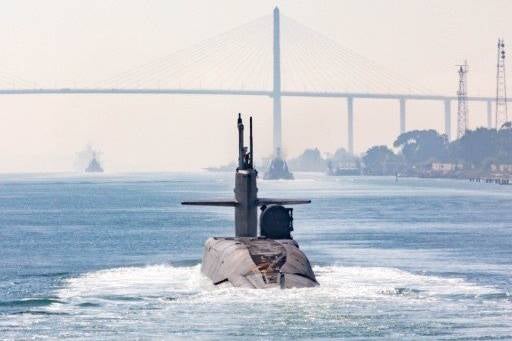Why has the US stationed a nuclear submarine in the Middle East?
The US has deployed submarines into the region before and announced its recent presence amid rising tensions with Iran
The US has admitted to stationing a nuclear-capable submarine in the Middle East.
It provided no other details in its online statement yesterday, though it posted an image that appeared to show a submarine in Egypt’s Suez Canal near its Suez Canal Bridge.
Central Command separately released an image of a nuclear-capable B-1 bomber also operating in the Middle East yesterday.
The acknowledgement of the location of the Ohio-class submarine by the US is incredibly rare. The nuclear submarine is part of America’s so-called “nuclear triad” of atomic weapons — which also includes land-based ballistic missiles and nuclear bombs aboard strategic bombers.
Ohio-class submarines can carry up to 24 ballistic missiles, with 12 warheads each, and can create damage equivalent to the distance of around 192 separate cities or other targets. However, it is unclear if the submarine operating in the Middle East carries nuclear ballistic missiles.
The US has deployed submarines into the region before and announced its recent presence amid rising tensions with Iran.
On November 5, 2023, an Ohio-class submarine arrived in the U.S. Central Command area of responsibility. pic.twitter.com/iDgUFp4enp
— U.S. Central Command (@CENTCOM) November 5, 2023
It comes a month after war broke out between Israel and Palestine on 7 October when Hamas terrorists stormed into Israel, killing more than 1,400 people and taking dozens hostage across the Gaza border.
Since then, Israel has launched retaliatory airstrikes on Gaza, resulting in the death of more than 10,000 Palestinians, according to health officials in the enclave.
The presence of the sub is to be used as a deterrent to prevent further escalation of conflict in the region that has already claimed the lives of thousands of people.
The conflict has also deepened tensions between the US and Iran after the country celebrated the Hamas attack on Israel.
Since the 1979 Iranian Revolution, Iran’s leaders have sought to undermine US influence in the Middle East by building their own coalition, comprising of Hamas, as well as the militant group Palestinian Islamic Jihad in Gaza; Tehran-affiliated militias in Syria, Iraq and Yemen; and Lebanon’s Hezbollah.
Iran, along with other members of the coalition, has supported the destruction of Israel.
While the country has denied direct involvement in the 7 October attack, and US officials and others have said that it is too soon to determine Iran’s exact role in the violence, a senior adviser to Iran’s Supreme Leader Ayatollah Ali Khamenei celebrated the attacks as a a “proud operation.”

“We support the proud operation,” Yahya Rahim Safavi said at a meeting held in support of Palestinian children in Tehran.
“We support this operation, and we are sure that the resistance front also supports this issue,” he added.
Iran has also threatened “preemptive” action against Israel if it continues its offensive in Gaza.
Meanwhile, Israel has exchanged daily artillery and rocket fire with Hezbollah since 7 October, as well as drawing a buffer zone near its border with Lebanon and bombing key airports in Syria.
It is feared these actions could bring Israel, one of America’s closest allies, closer to a war with a coalition backed by Iran, experts have warned.
As a result, the US has sought to de-escalate tensions to avoid the breakout of further conflict in the Middle East.
More than 17,000 US military personnel have been deployed to the region since the Hamas attack on Israel in early October.
Join our commenting forum
Join thought-provoking conversations, follow other Independent readers and see their replies
Comments
Bookmark popover
Removed from bookmarks